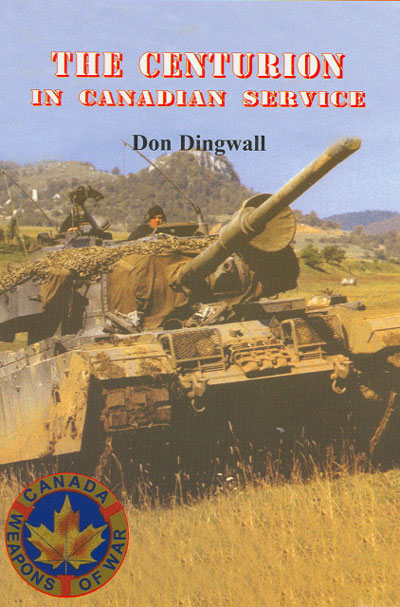The Centurion in Canadian Service
by Don Dingwall

"Weapons of War" Series; Service Publications, Ottawa, Ontario,
Canada, 2005; 24 pp. with B&W photos and one painting diagram; price
CDN $9.95; ISBN 1-894581-20-2 (http://www.servicepub.com)
Advantages: covers the user's history of this popular tank in Canada
Disadvantages: Alas, still no decent kits of one on the market to use
this information in building!
Rating: Highly Recommended
Recommendation: for all "Cent" fans and Canadian armor buffs
Over the years the Canadian Ministry of Defence found itself stuck quite
often between a rock (the US) and a hard place (the UK) when it came to
picking weapons systems. While in peacetime it was better to "buy
American" for servicing and compatibility, in wartime they found
themselves, as part of the Commonwealth, fighting as part of UK formations
with different kit. What to do?
In 1952 the Canadian Army began to take delivery of some 274 Centurion
Mark 3 tanks, and from that point on began a 38 year attachment with the
type. This was initially something of a shock as the tanks had a steep
user learning curve, especially the gunner.
Over the years the tanks were upgraded, first to Mark 5 status and later
to Mark 5/2 with the L7 105mm gun replacing the 20-lber. Next came the
Mark 6 with IR sights and lighting, and finally the Mark 11. Radios were
changed from UK pattern to Canadian pattern and finally to US sets in
1968.
Even with the complex gunsights, the Canadian Centurion crews were among
the best in NATO, maintaining excellence with the tank up through at least
1975. The highwater mark of the tank in Canadian service was probably
1971 with over 315 gun tanks in service. But by June 1977 the Centurion
was on its way out, leaving first-line service in Canada in 1979 in favor
of the new Leopard. Tanks were scrapped, quite often as "hard targets"
on gunnery ranges. A handful survive as memorials or museum pieces today,
such as a Mark 5 at CFB Borden in Worthington Park.
This book is an indispensable aid to anyone wanting to do up a Canadian
"Cent" and has a good selection of photos and some general information
on unit markings and paint schemes.
Overall this is a handy aid. One thing not mentioned was that, due to
the excellence of their gunnery, one of the premier NATO competitive events
in Germany was the Canadian Army Trophy Shoot, or CAT. It is probably
most fitting to note that the trophy itself was a large-scale sterling
silver model of a Centurion Mark 5.
Thanks to Clive Law of Service Publications for the review sample.
Cookie Sewell
|